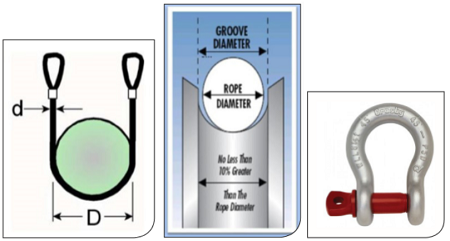Editor’s note: NATE’s TowerTimes ran an article in this month’s issue they have invited Inside Towers to share with our readers. The author is Caleb Messer with help from the members of the PAN Advisory Group: Craig Snyder, Jeremy Buckles, John Erichsen, Ken Hill, Michelle Kang, Marianna Kramarikova, and Scott Kisting. Due to the length and detail of the article, we will present it in two parts. (part one ran in yesterday’s issue)
Blocks
ASME B30.26 requires blocks be labeled with the manufacturer’s name or trademark, the rated WLL, and the compatible rope size(s). Like shackles, the ANSI/ ASSP A10.48 Standard further dictates that the WLL be provided in pounds or tons.
With the inherent versatility of common slings and shackles, there are few special compatibility concerns other than ensuring only OEM approved parts be used for items such as replacement shackles pins. That said, there are a few additional important considerations in the relationship between synthetic rope and rigging blocks that merit review.
D:d Ratio
The D:d ratio is a comparison of the pitch diameter around which a rope is being run (big “D”) vs. the nominal rope diameter (little “d”). The concern and ultimate derating from this D:d relationship involves increased and disproportionate force demands being placed on the localized extreme fibers within the rope segment located at the bend as the D:d ratio decreases.
The ANSI/ASSP A10.48 dictates a minimum 6:1 ratio for double-braid and kernmantle ropes, and a minimum 10:1 ratio for three-strand ropes. ASME B30.26 provides guidance on the effective calculation of the D:d ratio. The graphic on the top right illustrates the sheave pitch approach to calculating the ratio. Essentially, the center to center measurement from the rope on both sides of the block is the sheave pitch. This number is used in conjunction with the rope manufacturer’s stated diameter. For double-braid and kernmantle ropes, the sheave pitch diameter measurement must be greater than or equal to six times the diameter of the rope.
The use of the sheave pitch diameter for the D:d ratio calculation is why common ASME B30.26 compliant rigging blocks used in our industry with labeled compatible rope sizes of ½” and an inner sheave diameter slightly below 3” still meet the minimum 6:1 ratio when used with double-braid and kernmantle ropes.
Sheaves for Synthetic Rope vs. Wire Rope
With regards to the sheave groove profile, the ANSI/ASSP A10.48 states, “The size of the synthetic rope shall be compatible with the sheave groove in the rooster head and rigging blocks. Groove widths shall be greater than or equal to 1.10 times the rope diameter.” This requirement is one of the primary reasons why blocks may be categorized as either wire rope or synthetic rope blocks.
The narrower groove on the sheave of wire rope blocks introduces significant risk of rope milking or binding as it passes over the block. The wider groove enables the rope to spread over the sheave as it passes over the block enabling a smooth transition. The content on the previous page is only a surface level evaluation of the most common rigging components and relevant compatibility concerns. The generally accepted industry best-practice in order to make compliance straightforward is outlined below.
Operate your hoist following the manufacturer’s guidelines and make your hoist’s rated capacity your “weakest link” in the overall system, which for common receiver mounted capstan hoists would be 1,000 pounds of line pull capacity.
- Ensure your rope has all of the required documentation and labels, and has a published MBS no less than 10 times the hoist capacity, or no less than 10,000 pounds assuming a 1,000 pound rated capstan.
- Ensure your rigging block(s) are designed for use with synthetic rope, compatible for your given rope size(s), have a rated WLL no less than two times the rated capacity of your rope to account for a maximum block angle factor of 2.0, and used within the operating requirements established in ASME B30.26.
- Ensure your shackles also have a rated WLL no less than two times the capacity of your rope and are used within the operating requirements established in ASME B30.26.
- Ensure that your slings have a rated WLL no less than two times the capacity of your rope while in the sling’s lowest rated choked hitch configuration and used within the operating requirements established in ASME B30.9.
In case you’re interested in learning more about rigging principles, NATE has secured support from OSHA once again via the Susan G. Harwood Training Grant. This year’s content is “Advanced Rigging Principles Training”. The course is designed to filter rigging policies and practices specifically through the lens of a tower technician, with particular emphasis on the requirements of that ANSI/ASSP A10.48 Standard. The following section outlines the content of the Advanced Rigging Principles Course. Section 1: Introduction to NATE and OSHA Section 2: State of the Industry Section 3: Primary Regulations, Codes, Standards, and Policies Section 4: Synthetic Rope Section 5: Rigging Forces and Lift Systems Section 6: Hoisting Operations, Execution and Communication.
September 6, 2019





Reader Interactions